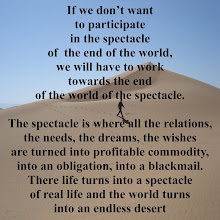Saturday, June 29, 2013
Slavoj Žižek: "Trouble in Paradise" On the protests in Turkey and Greece
In his early writings, Marx described the German situation as one in which the only answer to particular problems was the universal solution: global revolution. This is a succinct expression of the difference between a reformist and a revolutionary period: in a reformist period, global revolution remains a dream which, if it does anything, merely lends weight to attempts to change things locally; in a revolutionary period, it becomes clear that nothing will improve without radical global change. In this purely formal sense, 1990 was a revolutionary year: it was plain that partial reforms of the Communist states would not do the job and that a total break was needed to resolve even such everyday problems as making sure there was enough for people to eat.
Where do we stand today with respect to this difference? Are the problems and protests of the last few years signs of an approaching global crisis, or are they just minor obstacles that can be dealt with by means of local interventions? The most remarkable thing about the eruptions is that they are taking place not only, or even primarily, at the weak points in the system, but in places which were until now perceived as success stories. We know why people are protesting in Greece or Spain; but why is there trouble in such prosperous or fast-developing countries as Turkey, Sweden or Brazil? With hindsight, we might see the Khomeini revolution of 1979 as the original ‘trouble in paradise’, given that it happened in a country that was on the fast-track of pro-Western modernisation, and the West’s staunchest ally in the region. Maybe there is something wrong with our notion of paradise.
Sunday, June 23, 2013
"An Anarchy of Every day Life" by Jeff Shantz from Philosophers for Change
Contemporary anarchism offers a mid-range movement organized somewhere between the levels of everyday life, to which it is closest, and insurrection. Rooted in the former they seek to move towards the latter. Anarchists look to the aspects of people’s daily lives that both suggest life without rule by external authorities and which might provide a foundation for anarchist social relations more broadly. This commitment forms a strong and persistent current within diverse anarchist theories. This perspective expresses what might be called a constructive anarchy or an anarchy of everyday life, at once conserving and revolutionary.
Colin Ward suggests that anarchism, “far from being a speculative vision of a future society…is a description of a mode of human organization, rooted in the experience of everyday life, which operates side by side with, and in spite of, the dominant authoritarian trends of our society” (Ward, 1973: 11). As Graeber (2004) suggests, the examples of viable anarchism are almost endless. These could include almost any form of organization, from a volunteer fire brigade to the postal service, as long as it is not hierarchically imposed by some external authority (Graeber, 2004).
Even more, as many recent anarchist writings suggest, the potential for resistance might be found anywhere in everyday life. If power is exercised everywhere, it might give rise to resistance everywhere. Present-day anarchists like to suggest that a glance across the landscape of contemporary society reveals many groupings which are anarchist in practice if not in ideology.
Examples include the leaderless small groups developed by radical feminists, coops, clinics, learning networks, media collectives, direct action organizations; the spontaneous groupings that occur in response to disasters, strikes, revolutions and emergencies; community-controlled day-care centers; neighborhood groups; tenant and workplace organizing; and so on (Ehrlich, Ehrlich, DeLeon and Morris 18).
While these are obviously not strictly anarchist groups, they often operate to provide examples of mutual aid and non-hierarchical and non-authoritarian modes of living which carry the memory of anarchy within them. Often the practices are essential for people’s day-to-day survival under the crisis states of capitalism. Ward notes that “the only thing that makes life possible for millions in the United States are its non-capitalist elements….Huge areas of life in the United States, and everywhere else, are built around voluntary and mutual aid organisations” (Ward and Goodway, 2003: 105).
Kropotkin (1972: 132) notes that the state, the formalized rule of dominant minorities over subordinate majorities, is “but one of the forms of social life.” For anarchists, people are quite capable of developing forms of order to meet specific needs and desires. As Ward (1973: 28) suggests, “given a common need, a collection of people will…by improvisation and experiment, evolve order out of the situation — this order being more durable and more closely related to their needs than any kind of order external authority could provide.”
Order, thus arrived at, is also preferable for anarchists since it is not ossified and extended, often by force, to situations and contexts different than those from which it emerged, and for which it may not be suited. This order, on the contrary is flexible and evolving, where necessary giving way to other agreements and forms of order depending on peoples’ needs and the circumstances confronting them.
Living examples of the anarchist perspectives on order emerging “spontaneously” out of social circumstances are perhaps most readily or regularly observed under conditions of immediate need or emergency as in times of natural disaster and/or economic crisis, during periods of revolutionary upheaval or during mass events such as festivals. Anarchists try to extend mutual aid relations until they make up the bulk of social life. Constructive anarchy is about developing ways in which people enable themselves to take control of their lives and participate meaningfully in the decision-making processes that affect them, whether education, housing, work or food.
Ετικέτες
Anarchy,
beyond Post Modern,
Philosophy,
Political Theory
Wednesday, June 5, 2013
Video Channel from insurrected Turkey. Spread the News / Never Trust Mass Media!
This is a youtube channel with videos from revolted Turkey
Download them, share them, see them before the censorship delete them from internet!
The social uprising in Turkey continues and our friends and comrades in Turkey need the help from all of us.
Share the authentic news from underground media sources, express your solidarity with all possible ways,
help the message of revolted Turkish people to travel as further as possible
https://www.youtube.com/watch?v=aGjPubr5L5c&list=PLtMSwy96r2CaQstcSN2eJl13w9mnR3aTE
suggested videos: 5 7 14 18 25 27 31*
Ετικέτες
Anarchy,
Global Civil War,
Insurrection,
OCCUPY EVERYTHING,
riots,
Turkey
Saturday, June 1, 2013
Turkish police has started a war against the people. Many people are dead.
VOID NETWORK EXPRESSES SOLIDARITY FOR THE PEOPLE IN TURKEY AND THEIR STRUGGLE.
THE INTERNATIONAL STRUGGLE AGAINST GLOBAL TOTALITARIANISM CONTINUES!
WE SHALL OVERCOME!
The occupation of Taksim Gezi Park in İstanbul began on May 28th, 2013. Following the police raid in the park area on May 30th, hackers from the RedHack sabotaged the website of the Beyoglu police headquarters in response to the morning attack.
The occupation continued, and thousands of people gathered to resist the government’s plans (to build a shopping centre and destroy the green area). It soon became one of the largest mobilizations for years, with various different participants (from radical activists to NGOs, etc.), resembling the worldwide Occupy movement.
On May 31st, street clashes started from 5am in İstanbul. The resistance grew wider, while the police fired an incredible amount of tear gas bombs. Before yet another crackdown, supporters from three major football teams (Besiktas, Galatasaray, Fenerbahce) took to the streets united. Clashes continued late in the evening. The number of people in the streets was enormous. In every way, thousands were trying to reach Taksim square. After 16 hours of street fighting, the struggle went on.
Meanwhile, one man died of heart attack, but it was circulated that his death was not directly related to the police gas bombing. According to unconfirmed reports, two more persons were killed in Taksim: one young woman was reported dead after she was hit by cops on the head with gas bomb, while another young woman is said to have been crushed to death by a police panzer (anti-riot vehicle with water cannon).
At least 6 protesters suffered head injuries and were admitted to intensive care unit. In addition, more than 100 protesters were injured (among them, one congressman as well as journalists, who were also hospitalized).
Meanwhile, dozens have been detained by cops in Istanbul. Throughout the day, police forces constantly searched and detained people that had gasmasks, antacids, lemon juice to protect themselves from the effect of the huge amount of tear gas. For a better understanding of what is happening, it must be noted that the military does not act against protesters.
These protests have turned into a popular uprising, far beyond an environmentalist claim. At the same time, the developments have been completely gagged by the local mainstream media (one of the “alternative” communication channels currently used is twitter under #occupygezi and other hashtags).
Protests have spread nationwide, with several rallies at Turkish cities in solidarity with people repressed in İstanbul. Demonstrations were also scheduled in Holland, Germany and elsewhere in Europe.
Comrades in Turkey estimate that this is one of the biggest uprisings in recent years. Street clashes are ongoing tonight (31/5) from every direction to Taksim square. Nobody goes back home. It seems like everyone is determined to remain on the streets till morning.
Spread the word.
source: http://en.contrainfo.espiv.net/2013/05/31/istanbul-turkey-raw-updates-from-the-occupation-at-taksim-gezi-park/#more-17379
Subscribe to:
Posts (Atom)


































